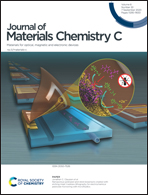A ratiometric optical strategy for bromide and iodide ion sensing based on target-induced competitive coordination of a metal–organic nanosystem†
Abstract
A ratiometric sensor through the built-in correction gains stronger anti-interference ability and more accurate analysis results compared with a single-signal sensor. Herein, a novel ratiometric assay platform coupled with fluorescence (FL) and scattering has been constructed for the selective and accurate quantization of Br−/I−. The ratiometric sensor is based on a metal–organic nanosystem, which is constructed via coordination bonding-induced self-assembly between non-conjugated polymer nanoparticles (NC-PNPs) and Hg(II), consequently displaying fluorescence and strong second-order scattering (SOS) signals. In the response system, the NC-PNPs function as a signal unit, and the Hg(II) ion serves as a recognition element. Upon the introduction of Br−/I−, the high affinity with Hg(II) makes Br−/I− snatch Hg(II) from the NC-PNP–Hg(II) nanosystem, causing the nanocomplex to disassemble. The target-triggered disaggregation results in a decrease in the SOS intensity, and meanwhile the Hg–Br− or Hg–I− compounds produced in situ reduce the FL intensity of the NC-PNPs via static quenching, suggesting the feasibility of ratiometric Br−/I− detection. Finally, the FL–SOS dual-signal strategy towards Br−/I− is successfully applied to real water/food samples. The ratiometric analytical platform coupled with FL and SOS offers a new perspective for applications based on target-induced aggregation and disaggregation behavior.



 Please wait while we load your content...
Please wait while we load your content...